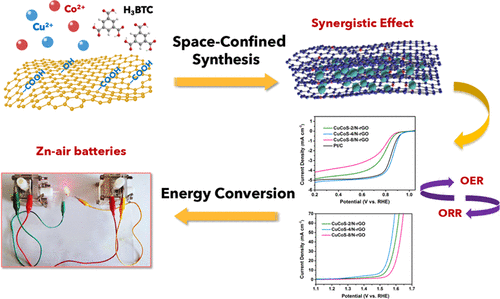当前位置:
X-MOL 学术
›
ACS Sustain. Chem. Eng.
›
论文详情
Our official English website, www.x-mol.net, welcomes your
feedback! (Note: you will need to create a separate account there.)
Space-Confined Synthesis of Lasagna-like N-Doped Graphene-Wrapped Copper–Cobalt Sulfides as Efficient and Durable Electrocatalysts for Oxygen Reduction and Oxygen Evolution Reactions
ACS Sustainable Chemistry & Engineering ( IF 7.1 ) Pub Date : 2020-01-10 , DOI: 10.1021/acssuschemeng.9b05710 Hang Zhang 1, 2, 3 , Xuemin Wang 1, 2, 3 , Zhao Yang 1, 2, 3 , Sihao Yan 1, 2, 3 , Cui Zhang 1, 2, 3 , Shuangxi Liu 1, 2, 3
ACS Sustainable Chemistry & Engineering ( IF 7.1 ) Pub Date : 2020-01-10 , DOI: 10.1021/acssuschemeng.9b05710 Hang Zhang 1, 2, 3 , Xuemin Wang 1, 2, 3 , Zhao Yang 1, 2, 3 , Sihao Yan 1, 2, 3 , Cui Zhang 1, 2, 3 , Shuangxi Liu 1, 2, 3
Affiliation

|
Searching for efficient and economical bifunctional oxygen electrocatalysts is urgent for exploring sustainable energy technologies. Herein, the unique lasagna-like structured copper–cobalt sulfides wrapped with N-doped reduced graphene oxide (CuCoS/N-rGO) were first fabricated through in situ controllable growth of bimetallic metal–organic frameworks (CuCo-BTC) on GO followed by further pyrolysis and sulfuration. The interconnected structure was formed because the bimetallic ions and carboxyl groups in the CuCo-BTC precursor combine with the functional groups (−COOH, −OH, etc.) on the surface of GO to interconnect the graphene sheets to avoid agglomeration of subsequent pyrolysis. In turn, the carbonized graphene was used as a space-constrained reactor to wrap CuCoS particles to prevent their aggregation and the electronic distribution changed between them to produce an excellent synergistic effect. In the exploration of the molar ratios of bimetallic ions, the optimal CuCoS-4/N-rGO with nCo/nCu of 4:1 possessed a unique structure, a larger specific surface area (150 m2 g–1), and splendid electrocatalytic activity, with the highest onset potential of 0.97 V (vs reversible hydrogen electrode, RHE), the largest limiting current density of 5.2 mA cm–, outstanding durability toward the oxygen reduction reaction, and the smallest overpotential of 288 mV (vs RHE) at 10 mA cm–2 toward the oxygen evolution reaction. Furthermore, lasagna-like CuCoS-4/N-rGO also showed satisfactory power density (143.2 mW cm–2) and prominent rechargeable ability compared with Pt/C when assembled in Zn–air batteries.
中文翻译:

宽面条状氮掺杂石墨烯包裹的铜钴硫化物的空间受限合成,作为高效且耐用的氧还原和析氧反应电催化剂
寻找有效和经济的双功能氧电催化剂对于探索可持续能源技术非常重要。在这里,首先通过在GO上原位控制双金属金属-有机骨架(CuCo-BTC)的生长来制造包裹有N掺杂的还原氧化石墨烯(CuCoS / N-rGO)的独特的千层面状结构化的铜-钴硫化物。进一步热解和硫化。形成互连结构的原因是,CuCo-BTC前体中的双金属离子和羧基与GO表面的官能团(-COOH,-OH等)结合在一起,使石墨烯片互连,从而避免了随后的热解结块。反过来,碳化石墨烯被用作空间受限的反应器来包裹CuCoS颗粒,以防止其聚集,并且电子之间的电子分布发生变化,从而产生出色的协同效应。在探索双金属离子的摩尔比时,最佳CuCoS-4 / N-rGO与n Co / n Cu为4:1具有独特的结构,较大的比表面积(150 m 2 g –1)和出色的电催化活性,最高启动电位为0.97 V(与可逆氢电极,RHE相比),最大极限电流密度为5.2 mA cm –,对氧还原反应具有出色的耐久性,在10 mA cm –2时对氧析出反应的最小过电势为288 mV(vs RHE)。此外,与Zn-空气电池组组装的Pt / C相比,类似千层面的CuCoS-4 / N-rGO还显示出令人满意的功率密度(143.2 mW cm –2)和出色的可充电能力。
更新日期:2020-01-10
中文翻译:

宽面条状氮掺杂石墨烯包裹的铜钴硫化物的空间受限合成,作为高效且耐用的氧还原和析氧反应电催化剂
寻找有效和经济的双功能氧电催化剂对于探索可持续能源技术非常重要。在这里,首先通过在GO上原位控制双金属金属-有机骨架(CuCo-BTC)的生长来制造包裹有N掺杂的还原氧化石墨烯(CuCoS / N-rGO)的独特的千层面状结构化的铜-钴硫化物。进一步热解和硫化。形成互连结构的原因是,CuCo-BTC前体中的双金属离子和羧基与GO表面的官能团(-COOH,-OH等)结合在一起,使石墨烯片互连,从而避免了随后的热解结块。反过来,碳化石墨烯被用作空间受限的反应器来包裹CuCoS颗粒,以防止其聚集,并且电子之间的电子分布发生变化,从而产生出色的协同效应。在探索双金属离子的摩尔比时,最佳CuCoS-4 / N-rGO与n Co / n Cu为4:1具有独特的结构,较大的比表面积(150 m 2 g –1)和出色的电催化活性,最高启动电位为0.97 V(与可逆氢电极,RHE相比),最大极限电流密度为5.2 mA cm –,对氧还原反应具有出色的耐久性,在10 mA cm –2时对氧析出反应的最小过电势为288 mV(vs RHE)。此外,与Zn-空气电池组组装的Pt / C相比,类似千层面的CuCoS-4 / N-rGO还显示出令人满意的功率密度(143.2 mW cm –2)和出色的可充电能力。











































 京公网安备 11010802027423号
京公网安备 11010802027423号